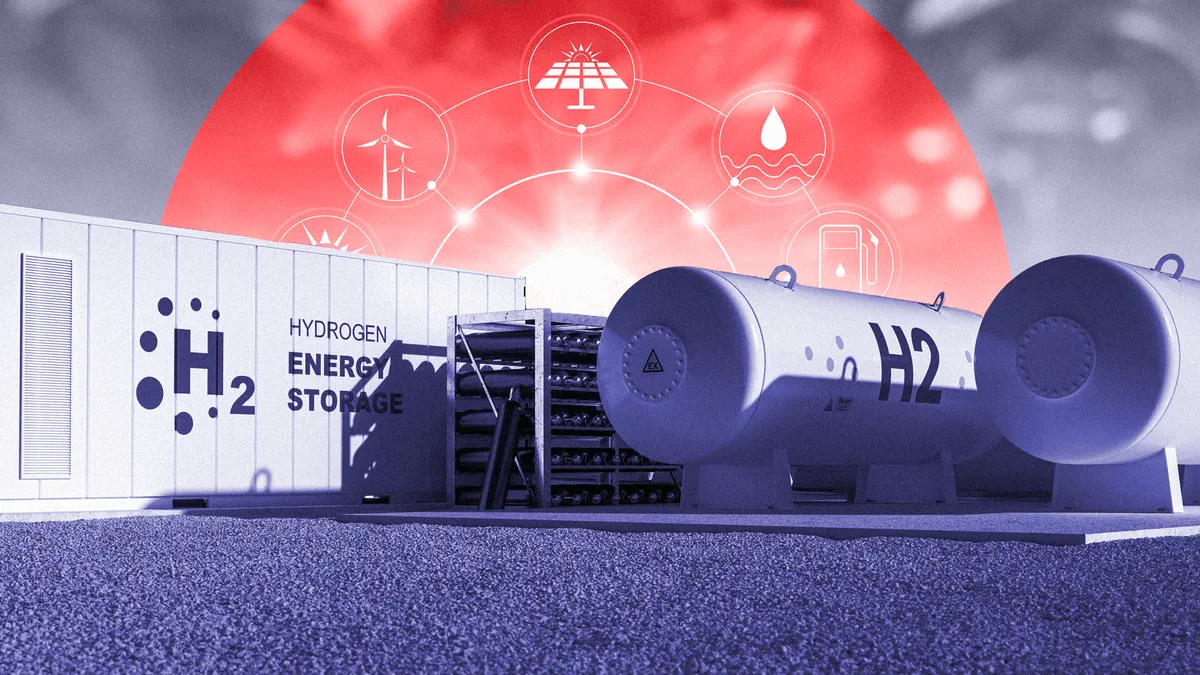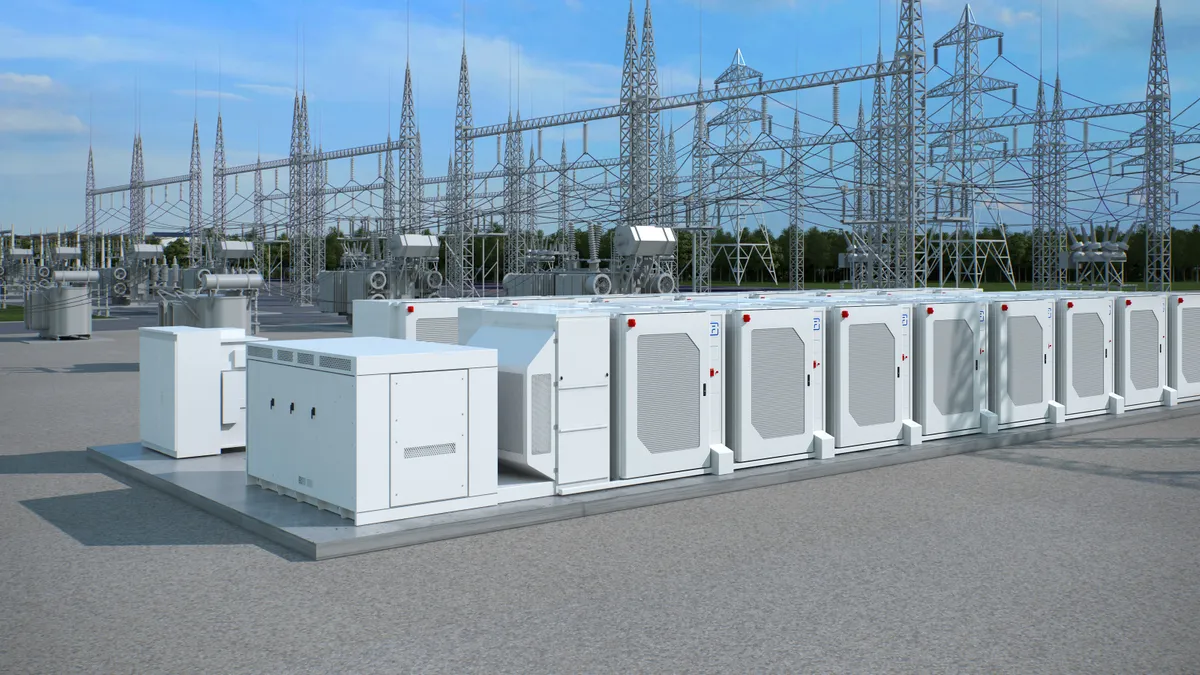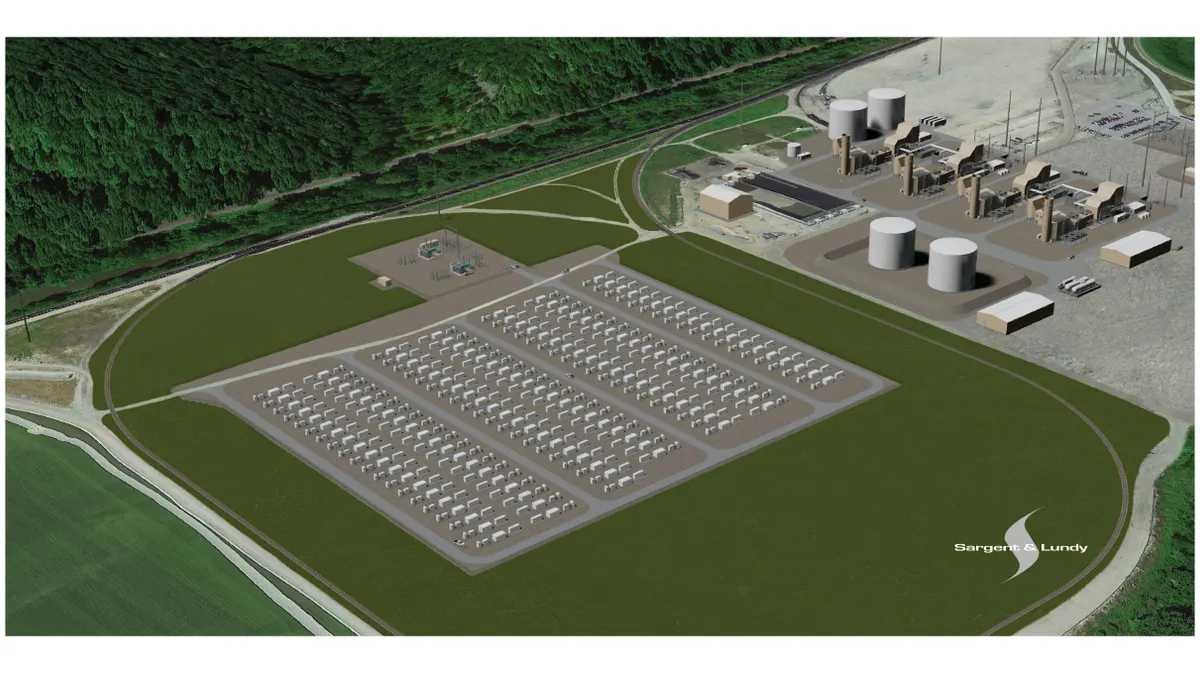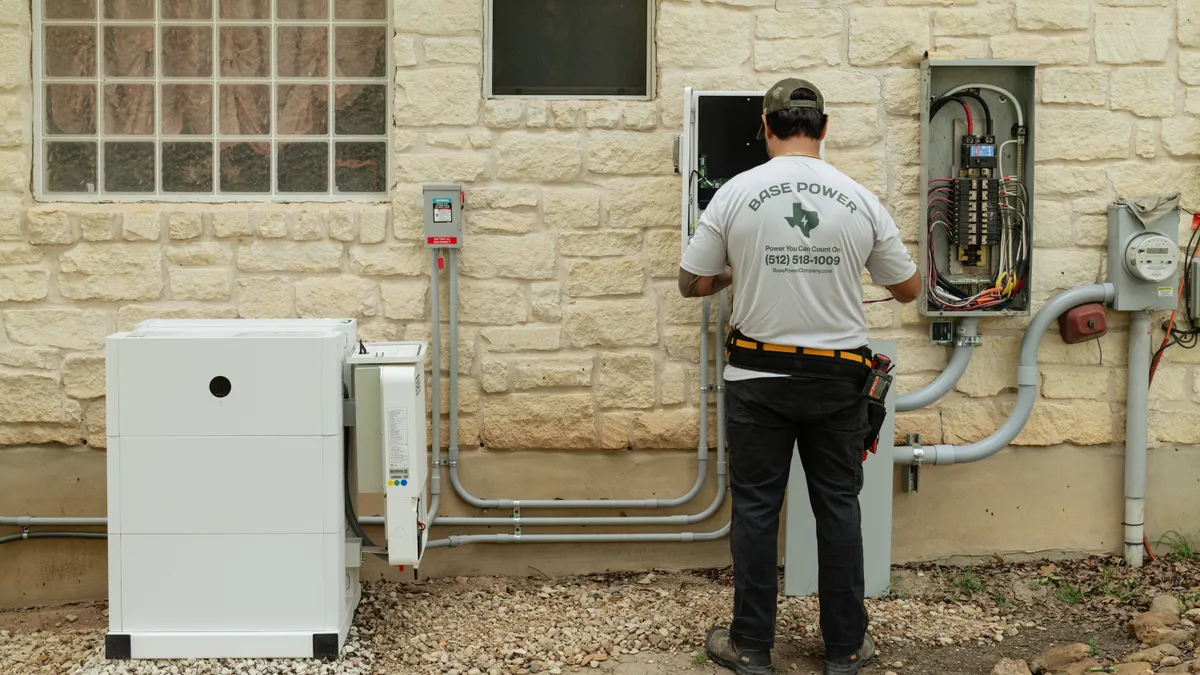At least 32 utilities are aiming to be carbon-free or achieve net-zero emissions by 2050. This is the first of a four-part series exploring the storage technologies that could get them there.
Jack Brouwer started thinking about the potential of using hydrogen to store massive amounts of energy around 12 years ago.
The idea was this: take inexpensive or excess renewable energy, run it through an electrolyzer to create hydrogen, store that hydrogen for as long as needed, and then use fuel cells to convert it back into electricity. Brouwer, a professor of mechanical and aerospace engineering at the University of California, Irvine, took the idea to the U.S. Department of Energy, and tried to convince the agency that the technology was essential to achieving carbon policy goals and supporting a renewables-heavy grid.
But the agency didn’t move forward with the idea so Brouwer and a group of his students began researching the issue. In 2013, they published a paper that looked at the potential of using large-scale compressed gas to store energy and smooth out intermittent wind resources. That paper caught the attention of some people at Southern California Gas Company (SoCalGas) — the nation’s largest gas utility — who reached out, saying they too had been thinking about the potential of hydrogen and wanted to talk, Brouwer said in an interview.
The discussion led to a demonstration project that was set up at UC Irvine’s campus in 2016, Brouwer said, that made renewable hydrogen from solar power using an electrolyzer — “and then taking that renewable hydrogen, injecting it into our natural gas grid and then delivering it, through our natural gas grid, to a natural gas combined cycle plant to make partially decarbonized electricity from it.”
It ran for four years. By the end, Brouwer’s vision for the technology had crystallized: transforming the natural gas delivery system into a renewable hydrogen delivery system, and using it as a cost-effective way to introduce massive amounts of storage.
"If you need to store terawatt hours of energy — which is what the grid will need if it’s 100% renewable — it’s going to be way cheaper to store it in the form of hydrogen," Brouwer said.
The industry’s interest in using power-to-gas as a storage vehicle comes against the backdrop of the broader transition in the energy landscape. Approximately one out of three Americans lives in a state or community that has committed to or achieved 100% clean electricity goals, according to a late 2019 report from the UCLA Luskin Center for Innovation. In addition, at least 32 utilities are aiming to be carbon-free or achieve net-zero emissions by 2050. And achieving a grid that runs predominantly on intermittent renewables will require large amounts of storage to smooth out supply for when the sun isn’t shining and wind isn’t blowing.
This decade is really an inflection point for the storage industry, said Dan Finn-Foley, head of energy storage at Wood Mackenzie. For the last five years, the sector has been working on establishing its value and ensuring that value is recognized, but that is going to rapidly give way to what Finn-Foley calls "this era of opportunity," where costs have declined to the point that storage begins competing with — and potential out-competing — other existing technologies.
"For intermediate [carbon reduction] targets, for steps up in the process, storage becomes a catalyst to help renewables get on to the grid more cost efficiently."

Daniel Finn-Foley
Head of Energy Storage, Wood Mackenzie
Pumped hydro accounts for a vast majority of large-scale storage in the country. But in recent years, battery storage — predominantly lithium-ion — has dominated new large-scale deployments. Finn-Foley expects lithium-ion will still be the dominant technology for new deployments in 2030. But a decade from now, the industry could be at another inflection point.
"Lithium-ion will probably be the dominant technology for four-hour systems," Finn-Foley said. There are two possible scenarios: one where a different technology has been able to innovate, especially on cost, to the extent where it has claimed the mantle of competition from lithium-ion at longer durations; and a second, where 10 years from now, "we have a crowded market place of non-lithium-ion technologies that are all throwing elbows around the right, 10, 20, 100-hour duration marks, trying to carve out a niche."
Right now, non-lithium ion technologies are essentially "training for the Olympics," Finn-Foley said — putting in the work now so they will be ready when the time comes to compete. They are commercializing their offerings, building up investment, creating pilot programs and aiming for scale.
But the need for incredibly long-duration storage — like days — isn’t likely to kick in until the last leg or final 10% of the clean energy transition, according to Finn-Foley.
"For intermediate [carbon reduction] targets, for steps up in the process, storage becomes a catalyst to help renewables get on to the grid more cost efficiently," Finn-Foley said. "With 100% targets, energy storage moves from a catalyst to a necessity."
For now, some utilities with aggressive renewables goals are focusing on diversifying their storage fleets — like the Los Angeles Department of Water and Power (LADWP), which last year announced plans to transition away from coal generation at its Intermountain Power Project to natural gas and eventually, by 2045, to 100% hydrogen.
"We’re looking at all these different technologies," including batteries, compressed air energy storage, as well as pumped hydro storage, a technology the utility has a lot of experience with, said James Barner, assistant director of the Clean Grid LA Strategy Division at LADWP.
"And then, the ultimate long-term energy storage, which is hydrogen," Barner added.
Weeks — or even months — of storage
Experts caution that there are challenges to getting power-to-gas technology to that point, including upgrading existing infrastructure to be able to carry hydrogen.
"The [first] enabler for power-to-gas will be low-cost electricity," said Kevin Harrison, senior engineer at the National Renewable Energy Laboratory. "If you don’t have low cost electricity — less than 5 cents per kWh — power-to-gas might not make sense no matter where you are."
The second enabler is low-cost electrolyzer systems, which is a substantial chunk of the operating cost of the technology, according to Harrison.
In March, technology group Wärtsilä published a whitepaper that outlined two approaches to power-to-gas. The first involves capturing carbon dioxide from the atmosphere, electrolyzing water to create hydrogen, and then combining the hydrogen and carbon to create methane, which can be put into existing natural gas infrastructure. The second is direct power-to-hydrogen — running electrolyzers on surplus renewables to create hydrogen.
Large-scale projects "are going to bring down the capital cost of building a hydrogen facility substantially. And once that happens, it’s going to start making a transition to [where] the cost of hydrogen is really driven by the cost of electricity, more than the cost to build the facility."

Jason Rowell
Associate Vice President and Global Technology Portfolio Manager, Black & Veatch
The idea makes a lot of sense, especially in places like California, where excess solar power has to be sent for free or at a negative price to neighboring states because it exceeds demand, said Jean-Louis Kindler, CEO of renewable hydrogen company Ways2H. That excess power can be used to run an electrolyzer, create hydrogen out of water, and then store it underground — "I would say almost indefinitely, so it’s beyond seasonal."
Kindler isn’t alone — several industry players are taking a closer look at the possibilities that hydrogen could offer the storage sector, and the costs of green hydrogen could fall by 64% by 2040, according to research from Wood Mackenzie.
The entire West Coast has a lot of potential in terms of hydrogen, said Jason Rowell, associate vice president and global technology portfolio manager at Black & Veatch. Rowell thinks that by 2025, hydrogen will be used more substantially in the transportation sector. By 2030, Rowell expects it will grow its presence in the power sector, driven in part by a few "mega projects" — like the Intermountain project — that have been announced.
Projects of that scale "are going to bring down the capital cost of building a hydrogen facility substantially. And once that happens, it’s going to start making a transition to [where] the cost of hydrogen is really driven by the cost of electricity, more than the cost to build the facility," Rowell said.
The biggest value add of power-to-gas — the reason it’s "a different ballgame entirely" — is duration, according to Joe Ferrari, former general manager of utility market development at Wärtsilä North America and current regional sales manager at MAN Energy Solutions. Lithium-ion batteries tend to hover around the four-hour range, with some creeping up to eight and 12 hours, while pumped hydro also provides around 12 hours of storage, making those technologies a good way to shift energy from one part of the day to another, Ferrari noted.
But power-to-gas provides long-term energy storage — meaning weeks, or even months of energy. And a high renewables grid will require seasonal storage to counter seasonal trends in solar, wind and hydroelectric output, Ferrari added.
The Wärtsilä whitepaper explored a California-specific scenario that included a fast build-out of renewables and battery storage, with power-to-gas introduced in the final years of the state’s clean energy trajectory, and found that the state could reach its renewables goals five years ahead of schedule.
The utility perspective: a growing interest in hydrogen
Utilities are beginning to take a closer look at hydrogen too — especially gas utilities, according to Ferrari.
"In California, for example, they want to get to zero carbon emissions," Ferrari said. "So if you’re a natural gas utility, you are either facing the prospect of having your business become illegal, because you can’t sell fossil gas anymore… or you can transition to some type of renewable gas," like hydrogen or synthetic methane.
In August, Jeffrey Martin, chairman and CEO of Sempra Energy — parent company of SoCalGas — said the company is "quite bullish" on the technology and is trying to position itself as a leader in the space. And in July, on an earnings call, NextEra Energy Executive Vice President and Chief Financial Officer Rebecca Kujawa said the company is "particularly excited about the long-term potential of hydrogen," and plans to propose a pilot project at Florida Power and Light, which will tentatively come online in 2023.
LADWP, meanwhile, is adopting a phased approach to its upcoming hydrogen facility. The utility is aiming to supply 100% renewable energy resources by 2045, said Ashkan Nassiri, manager of strategic initiatives at LADWP. It plans to phase out its 1,800 MW coal plant at the Intermountain Power Project and repower it with a combined cycle facility. That transition will reduce the facility’s greenhouse gas emissions by two or three times, according to Nassiri. To decrease them further, LADWP plans to have the capability to run the plant with a 30% hydrogen fuel mix on day one, eventually scaling up to close to 100%.
The storage component comes into effect down the line "when we’re closer to, let’s say, 80% or 90% [renewables]," Nassiri said.
But LADWP doesn’t want to pick one winner in terms of storage technologies, Nassiri added. Instead, it’s aiming for a diversified portfolio, where different technologies will address different situations: whether the utility is simply trying to shift power from the 8 am to 2 pm period to later in the evening, or instead, capture energy in the spring and use it only in the summer.
"[Y]ou’d need roughly 40 GW worth of lithium-ion batteries to have the same amount of storage potential in just one of our caverns."

Mike Ducker
Vice President of Renewable Fuels, Mitsubishi Power
Adjacent to the Intermountain site is another planned facility — the Advanced Clean Energy Storage (ACES) project, a joint effort between Mitsubishi Power and Magnum Development. When the project was announced in 2019, it was focused on four storage technologies: hydrogen, compressed air energy storage, flow batteries and solid oxide fuel cells. But while those other technologies remain within the scope of interest, the developers’ focus has settled predominantly on hydrogen, given "the unprecedented amount of interest and support" in the technology for long-term energy storage, said Mike Ducker, vice president of renewable fuels at Mitsubishi Power.
One of the caverns at the ACES site can store upwards of 150,000 MWh worth of renewable energy, according to Ducker.
"That means you’d need roughly 40 GW worth of lithium-ion batteries to have the same amount of storage potential in just one of our caverns," Ducker added.
The developers are aiming to have the project ready to go in 2024, although a lot hinges on working with entities and off-takers in the region, Ducker said. And although the facility is completely separate from the Intermountain project, "we are working with the [Intermountain Power Agency] in anticipation and desire to provide the hydrogen — both the production and storage — in support of their project."
What’s next? Potential policy pushes, building scale and creating demand
At the same time, power-to-gas or hydrogen technologies face certain limitations. A tank can be built anywhere, but it’s cheaper to store hydrogen below ground, which is why a lot of people are looking specifically to underground storage, including in salt caverns, Brouwer noted.
"[I]n order to take advantage of existing storage systems and transmission and distribution systems, you would need some serious upgrades — if not replacement — of a lot of that infrastructure."

Joe Ferrari
Regional Sales Manager, MAN Energy Solutions
And then there’s the larger question around infrastructure. Most facilities in the United States designed to store and transport gas were built around methane, according to Ferrari. But hydrogen is a completely different molecule and the metallurgy of the existing systems may not work with it.
"So in order to take advantage of existing storage systems and transmission and distribution systems, you would need some serious upgrades — if not replacement — of a lot of that infrastructure," Ferrari explained.
The next big requirement is a policy push, Ferrari thinks — a signal from regulators to let electric utilities know that hydrogen is an option.
"Then that gives motivation to the utilities to just add one more degree of freedom to their planning," Ferrari said.
There are multiple steps of evolution that the technology will need to go through to get to the point where it can play a role in 100% decarbonization, said Georgios Papadimitriou, head of North America at Enel Green Power. The first is building scale with electrolyzers and ensuring they can handle larger amounts of energy. The second issue is targeting industries that could benefit from green hydrogen at a competitive price — like the cement sector — which will in turn create a positive loop to stimulate the electrolyzer industry, according to Papadimitriou. There’s also potential to create new demand in hard-to-electrify sectors, like shipping, aviation and heavy-duty transport.
"That could be something that could work in the next, let’s say decade so that we’re creating more demand for the product," Papadimitriou said. "And while we do all that and we make the hydrogen chain of production and consumption more scalable and more mainstream — at that point, we can consider [power to gas to power]."
Clarification: A quote in this story has been updated to clarify that Enel's Georgios Papadimitriou is referring to power-to-gas-to-power technology.






















